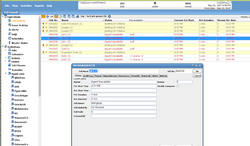Software:Tidal Enterprise Scheduler
Tidal Enterprise Scheduler (TES) is a job scheduler originally created by Tidal Software, Inc. It was purchased by Cisco Systems and more recent versions are to be named Cisco Workload Automation (CWA). More recently this category of software is increasingly labeled as "workload automation", which is an industry term for the next generation of job scheduling applications. It is comparable to BMC Control-M or CA Workload Automation AE.
The core functionality of TES is the ability to schedule batch jobs. It is designed to carry out repetitive tasks as defined in a schedule based upon calendar and event conditions. A calendar can be simple or intricate depending upon design.[1]
Tidal works as a distributed system that can be controlled from a centralized location (master server) which agents connect to. This allows batch jobs to be run, unattended in the background across a list of servers.[2]
History
Cisco Tidal Enterprise Scheduler is one of the oldest enterprise batch schedulers still in active production. It dates back to 1979 when it was originally created by Tidal Software in Palo Alto, California.[3]
It is used by a large distribution of organizations and has helped to define the industry. It is in use by over 400 organizations.[4]
In 2009 it was purchased by Cisco Systems where development continues.[5][6] Tidal is now offered as their primary workload automation solution. [citation needed]
On Nov 16, 2017, Dillon Kane Group (DKG) completed acquisition of Cisco Workload Automation, which was renamed to Tidal Workload Automation.[7]
Platforms
Batch jobs are scheduled and run across different operating system platforms and business application environments.
Agents are supported on the following platforms:
Advanced features
Beyond simply running jobs, in the background, on a schedule, a more elaborate set of functionality is provided:
- Dependencies (jobs, files, events)
- Users, permissions, authentication
- Master/Agent architecture - distributed environment
- Clustering with Master/Backup/Faultmon to prevent single point of failure[8]
Criticism
GUI performance
Notable issues may include GUI performance and lag during user interaction. Performance of the interface may degrade when displaying large lists of jobs or agents.[9] No studies or benchmarks showing performance data have been published. Performance concerns may be highly dependent on underlying hardware and architecture implementations.
Future
Tidal is geared towards supporting new technologies including cloud, mobile, and big data. It is designed for scalability and automation. It has been built to work as a component with Cisco's other technologies.[10][2]
See also
References
- ↑ "Tidal Enterprise Scheduler Datasheet". Tidal Software. October 2007. http://www.duke.se/res/Tidal/Tidal-Enterprise-Scheduler-Brochure.pdf. Retrieved February 21, 2018.
- ↑ Jump up to: 2.0 2.1 "Dillon Kane Group has completed acquisition of Cisco Workload Automation". Cisco. November 16, 2017. http://www.cisco.com/c/en/us/products/analytics-automation-software/tidal-enterprise-scheduler/index.html. Retrieved February 21, 2018.
- ↑ "Tidal Software". Crunchbase. https://www.crunchbase.com/organization/tidal-software#/entity. Retrieved February 21, 2018.
- ↑ Gilbert, Mike (December 2006). "Job Scheduling on Windows" (PDF). Legacy Directions. http://www-ti.informatik.uni-tuebingen.de/~spruth/edumirror/xx059.pdf. Retrieved February 21, 2018.
- ↑ "Tidal Software, Inc.: Private Company Information". Bloomberg. May 19, 2009. https://www.bloomberg.com/research/stocks/private/snapshot.asp?privcapId=35569. Retrieved February 21, 2018.
- ↑ "Cisco has Acquired Tidal Software, Inc.". Cisco. http://www.cisco.com/c/en/us/about/corporate-strategy-office/acquisitions/tidal.html. Retrieved February 21, 2018.
- ↑ "Dillon Kane Group has completed acquisition of Cisco Workload Automation". November 16, 2017. https://www.cisco.com/c/en/us/about/corporate-strategy-office/acquisitions/dkg-workload-automation.html. Retrieved April 16, 2018.
- ↑ "Cisco Workload Automation At-A-Glance". Cisco. 2016. http://www.cisco.com/c/dam/en/us/td/docs/data_virtualization/TES/TES-AAG.pdf. Retrieved February 21, 2018.
- ↑ "What is Tidal?". Tidal Enterprise Scheduler. http://tidal-enterprise-scheduler.com/what-is-tidal. Retrieved February 21, 2018.
- ↑ "Tag Info: About Tidal Scheduler". Stack Overflow. https://stackoverflow.com/tags/tidal-scheduler/info. Retrieved February 21, 2018.


